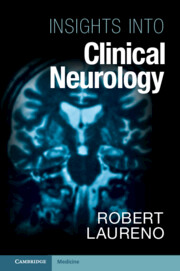Book contents
- Insights into Clinical Neurology
- Insights into Clinical Neurology
- Copyright page
- Dedication
- Contents
- Preface
- Acknowledgments
- Chapter 1 The Amnesic Syndrome
- Chapter 2 Aphasia, Apraxia, and Agnosia
- Chapter 3 Spurious Symptoms and Behaviors
- Chapter 4 Hallucinations
- Chapter 5 Grasping and the Grasp Reflex
- Chapter 6 Asterixis
- Chapter 7 Discussion of the Upper Motor Neuron Syndrome
- Chapter 8 Some Aspects of the Lower Motor Neuron Syndrome
- Chapter 9 The Limbic System
- Chapter 10 Vibration Sensation, the Posterior Columns, and Related Topics
- Chapter 11 Transneuronal Effects
- Chapter 12 Spinal Nerve Roots
- Chapter 13 Ischemic Hypoxic Encephalopathy
- Chapter 14 The Liver–Brain Relationship in Wilson Disease
- Chapter 15 Wernicke Disease
- Chapter 16 Delayed Neurologic Disorders after Toxic or Metabolic Insults
- Chapter 17 Transolfactory Spread in the Pathogenesis of Meningoencephalitis
- Chapter 18 Neurologic Disorders in Endocarditis
- Chapter 19 Secondary Abscess Formation in Primary Brain Lesions
- Chapter 20 Progressive Multifocal Leukoencephalopathy: The Early Years
- Index
- References
Chapter 7 - Discussion of the Upper Motor Neuron Syndrome
Published online by Cambridge University Press: 27 July 2023
- Insights into Clinical Neurology
- Insights into Clinical Neurology
- Copyright page
- Dedication
- Contents
- Preface
- Acknowledgments
- Chapter 1 The Amnesic Syndrome
- Chapter 2 Aphasia, Apraxia, and Agnosia
- Chapter 3 Spurious Symptoms and Behaviors
- Chapter 4 Hallucinations
- Chapter 5 Grasping and the Grasp Reflex
- Chapter 6 Asterixis
- Chapter 7 Discussion of the Upper Motor Neuron Syndrome
- Chapter 8 Some Aspects of the Lower Motor Neuron Syndrome
- Chapter 9 The Limbic System
- Chapter 10 Vibration Sensation, the Posterior Columns, and Related Topics
- Chapter 11 Transneuronal Effects
- Chapter 12 Spinal Nerve Roots
- Chapter 13 Ischemic Hypoxic Encephalopathy
- Chapter 14 The Liver–Brain Relationship in Wilson Disease
- Chapter 15 Wernicke Disease
- Chapter 16 Delayed Neurologic Disorders after Toxic or Metabolic Insults
- Chapter 17 Transolfactory Spread in the Pathogenesis of Meningoencephalitis
- Chapter 18 Neurologic Disorders in Endocarditis
- Chapter 19 Secondary Abscess Formation in Primary Brain Lesions
- Chapter 20 Progressive Multifocal Leukoencephalopathy: The Early Years
- Index
- References
Summary
In the upper motor neuron syndrome, there are abnormalities of spinal reflexes. The disordered monosynaptic muscle stretch reflex is manifest by a velocity dependent increase in muscle tone and exaggerated tendon jerks. The cutaneous reflex to plantar stimulation is abnormal in that plantar flexion of the great toe is lost. Disinhibition of the polysynaptic spinal flexion reflex is responsible for the Babinski sign and the clasp-knife phenomenon.
Keywords
- Type
- Chapter
- Information
- Insights into Clinical Neurology , pp. 44 - 47Publisher: Cambridge University PressPrint publication year: 2023



